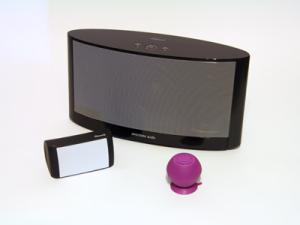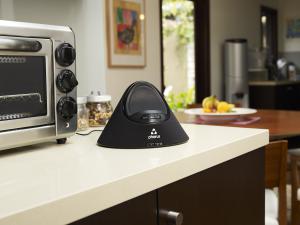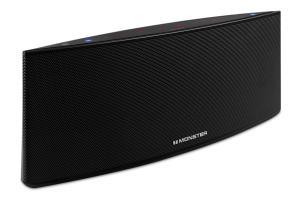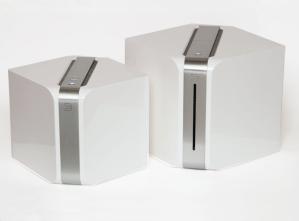What wireless technology is right for you?
Comparison of AirPlay, Bluetooth, DLNA, Play-Fi, Sonos and other technologies

In the field of audio, wires are gradually becoming history, as has already happened to switched modems. Most modern portable systems, like a large number of headphones, sound panels and receivers, are built using built-in wireless technology.
This technology allows you to stream audio from your smartphone to wireless speakers or from an iPad to the sound bar, or from a network hard drive to your Blue-ray player.
')
Most of these products include only one type of wireless technology. It is important to make sure that the new wireless audio system you are buying will work with your smartphone, laptop or any other device from which you prefer to listen to music.
In this article, I'm going to look at the most popular wireless audio technologies and help you understand which one is best for you.
Airplay

Cambridge Audio Minx Air 200 uses AirPlay as its core wireless technology and also supports Bluetooth
Advantages:
- Works with multiple devices in multiple rooms.
- No loss of sound quality
Disadvantages:
- Does not work with Android devices
- Does not work outside the house (with some exceptions)
- No stereo pair support
If you have any device from Apple, or at least a PC with iTunes, then you have AirPlay. This technology transmits audio from any iOS device (iPhone, iPad, iPod touch) or computer using iTunes. It transmits audio to AirPlay-enabled wireless audio speakers, sound bars and an audio / video receiver, and can also work with your audio system if you connect AirPort Express or Apple TV.
Music lovers like AirPlay, because this technology does not degrade the sound quality and does not compress music files. It only works with audio formats that iTunes supports, and also allows you to listen to Internet radio and podcasts from iTunes or applications on the iPhone and iPad.
This site contains detailed instructions for using AirPlay.
AirPlay uses your home Wi-Fi network, so it only works at home. Several AirPlay speakers, such as Audio Pro AllRoom and Libratone Zipp, are equipped with a built-in Wi-Fi router and do not need to connect to a Wi-Fi network to operate AirPlay. Apparently, the AirPlay synchronization is not reliable enough, which does not allow the use of two AirPlay speakers in stereo pair mode.
You can play audio from one or more devices on multiple speakers simply by using the AirPlay control menu on your phone, tablet, or computer, and choosing which speakers you want to connect. Thus, AirPlay is suitable for family use, when several people want to listen to different music at the same time, as well as for parties, if you want one music to play throughout the house.
AVB (Audio Video Bridging)

AVB is still looking for its way to the consumer audio market, but it is already well established as a professional audio product due to the line of digital signal processors Biamp Tesira
Advantages:
- Works with multiple devices in multiple rooms.
- Allows you to work together several products of different brands.
- Does not affect sound quality, compatible with all formats
- It achieves almost perfect synchronization (1 ms), which allows using a stereo pair
- Industrial standard - not controlled by one company
Disadvantages:
- Unavailable as a consumer audio product. Currently, only a few network products support AVB.
- Does not work outside the house
The AVB standard, also known as 802.11, is a new industry standard that allows multiple devices on a network to “use” a common clock that syncs approximately every second. Packages with audio (and video) data are marked with temporary instructions, which, in fact, say: "Play this data packet at 11: 32: 43.304652." Synchronization is as good as using simple audio cables.
I did not include AVB in the list because it is a real option for you (not yet), but because I believe that you will hear more about this technology. Right now, AVB support is included in several network products and computers and in several professional audio products, but I'm afraid not in consumer goods.
Curiously, AVB does not necessarily replace existing technologies, such as AirPlay, Play-Fi and Sonos. In fact, AVB can be added to them, and I believe that, to some extent, this will happen.
Bluetooth

There are a large number of shapes and sizes of Bluetooth speakers. Shown here are Peachtree Audio deepblue (far), Cambridge SoundWorks Oonz (front left) and the AudioSource SoundPop (front right)
Advantages:
- Works with any smartphone, tablet or computer
- Works with a lot of speakers and headphones.
- Works anywhere
- Allows you to use a stereo pair
Disadvantages:
- May lower sound quality
- Difficult to use in different rooms.
- Works at short distances
Bluetooth is one of those formats that is used almost everywhere. It is in Apple and Android-smartphones and tablets, and if your laptop does not support it, then you can purchase an adapter for less than $ 15. It is built into countless wireless speakers, headphones, sound panels and audio / video receivers. You can purchase a Bluetooth adapter for less than $ 30 and use it in your current audio system.
For music lovers, the disadvantage of Bluetooth is that it almost always, to some extent, degrades the sound quality, because it uses data compression to reduce the size of the original audio stream to the size of the Bluetooth bandwidth. The standard encoding-decoding technology (codec) in Bluetooth is called SBC. However, Bluetooth devices can use other codecs, such as AAC, apt-X, and various MPEG codecs (including MP3).
If the source (your phone, tablet or computer) and the receiving device (wireless receiver or speaker) support a specific codec, then the data encoded with this codec does not require an additional layer to add compressed data. Therefore, if you are listening to, say, an MP3 file with a bit rate of 128 kbps or using an audio streaming service and your output device accepts MP3, Bluetooth does not need to add an extra level of compression, and as a result, the sound is played without loss.
The degradation of sound that can occur when using Bluetooth - is it audible? On a high-quality audio system - yes. On a small wireless speaker, perhaps not. Bluetooth speakers offering AAC or apt-X audio compression options that are considered to be superior to the Bluetooth standard are likely to provide better results, but only some phones and tablets are compatible with these formats. An online auditory test allows you to compare aptX and SBC.
Any application on your smartphone, or tablet, or computer will work normally with Bluetooth, and connecting two Bluetooth devices is quite simple.
Bluetooth does not require a Wi-Fi network, so it works everywhere: on the beach, in a hotel room, even when driving a bicycle or motorcycle. However, the distance of use is limited and is usually 15 feet. 30 feet at best.
As a rule, Bluetooth does not allow transmission to multiple audio systems. The only exceptions are systems that can work in pairs: with one speaker playing the left channel, while the other plays the right channel. Some of these devices, such as the Beats and Jawbone Bluetooth speakers, can play a mono signal on each speaker, so you can place one speaker, say, in a living room, and the other in an adjacent one. Although you still need to take into account the remote limitations of Bluetooth. Summary: if you want to listen to music in different rooms - do not use Bluetooth.
DLNA

JBL L16 is one of the few wireless speakers that supports DLNA wireless broadcasting.
Advantages:
- Works with many audio / video devices, such as Blue-ray players, TV and audio / video receivers
- No loss of sound quality
Disadvantages:
- Does not work with Apple devices
- Does not broadcast on multiple devices
- Does not work outside the house
- Works only with saved music files. Does not work with streaming audio.
DLNA is a network standard, not a wireless audio technology. But it allows you to play files stored on network devices, because it has applications for working with wireless audio. It is not available on Apple phones and tablets running iOS, but DLNA-compatible applications, such as Skifta , are available for Android devices. Moreover, DLNA works with a PC running Windows, but not with an Apple Mac.
Only a few wireless speakers support DLNA, but this is a standard feature on conventional audio / video devices such as Blue-ray players, TV and audio / video receivers. This is useful if you want to, say, stream music from your computer to a home theater system using a receiver or a Blue-ray player. Or broadcast music from your computer to your phone (DLNA is great for viewing photos from a computer or phone on TV, but now we are talking about audio).
Since DLNA is a technology based on Wi-Fi, it does not work outside the home network. Since, in its essence, DLNA is a technology for file sharing, and not broadcasting technology, the sound quality is not reduced. However, it does not work with Internet radio and streaming services, although a large number of DLNA-compatible devices already have these built-in functions. DLNA is able to simultaneously play audio on only one device, so it is inconvenient to use it to play music throughout the house.
Play-fi

This PS1 Phorus speaker uses Play-Fi sound technology.
Advantages:
- Works with any smartphone, tablet or computer
- Works with multiple devices in multiple rooms.
- No loss of sound quality
Disadvantages:
- Works (for now) with only a few wireless speakers.
- Does not work outside the house
- Limited streaming capabilities (for now)
Play-Fi was declared as a “platform independent” version of AirPlay, in other words, it should work with everything. There is a Play-Fi app for Android devices, and an app for Apple devices running iOS, and also adds support for Windows-based personal computers. Play-Fi appeared at the end of 2012, and by the time this article was written, only a few Play-Fi devices were available. Play-Fi is licensed by DTS, a recognized audio technology company known for its technology used in many DVDs, and it’s highly likely that the universe of Play-Fi devices will expand over time.
Like AirPlay, Play-Fi technology does not reduce the sound quality. It can be used to transfer sound from one or more devices to multiple audio systems, so that it is convenient if you want to play music throughout the house, or you want family members to listen to different music in different rooms.
Play-Fi works over Wi-Fi, so you cannot use it outside the network. The Play-Fi app for Android currently includes Internet radio and music broadcasting via Pandora, Deezer and Songza, but any other streaming options are available only in the Asian market.
Qualcomm AllPlay

Monster S3 is one of the first speakers that use Qualcomm AllPlay
Advantages:
- Works with any smartphone, tablet or computer
- Works with multiple devices in multiple rooms.
- No loss of sound quality
- Supports high resolution audio
- Products from different manufacturers can work together.
Disadvantages:
- Products announced but not yet available
- Does not work outside the house
- Streaming capabilities are somewhat limited.
AllPlay is Wi-Fi based technology from the manufacturer of Qualcomm processors. It allows you to play audio in ten zones (rooms), each of which plays the same or another audio recording. Volume can be monitored simultaneously for all speakers or in each zone separately. At the time of writing, AllPlay provides access to nine different streaming services, including Spotify, iHeartRadio, TuneInRadio, Rhapsody, Napster, and more. They are not managed by a separate application, as in the case of Sonos, but within the streaming services application that you use. The technology also makes it possible to use the products of competing manufacturers together, as long as they support AllPlay.
AllPlay is a lossless compression technology that does not affect playback quality. It supports many basic codecs, including MP3, AAC, ALAC, FLAC and WAV, and can work with audio files with resolutions up to 24/192.
At the time of writing this article, no company supplied its product with AllPlay technology, although Panasonic and Monster showed products equipped with it at the September international consumer electronics show (IFA show) in 2014. Altec Lansing also announced that they will use AllPlay in future projects.
Sonos

Play3 is one of the smallest models of Sonos wireless speakers.
Advantages:
- Works with any smartphone, tablet or computer
- Works with multiple devices in multiple rooms.
- No loss of sound quality
- Allows you to use a stereo pair
Disadvantages:
- Available only on Sonos audio systems.
- Does not work outside the house
Although Sonos wireless technology is only available on Sonos devices, their competitors have told me that it remains the most successful wireless audio company. At the moment, the company offers two wireless audio speakers, a sound panel, a wireless amplifier (using your own speakers) and a wireless adapter that plugs into your existing stereo equipment. The Sonos app runs on Android and iOS smartphones and tablets, on Windows and Mac.
The Sonos system does not reduce the quality of audio playback, since it does not use data compression. Anyway, Wi-Fi is necessary for its operation, therefore it does not function outside the network. You can transfer one audio track to each audio speaker in the house, you can broadcast different audio recordings to different speakers, and so on in any other combinations.
Sonos required each Sonos device to have a wired Ethernet connection with your router, otherwise you had to buy a Sonos wireless bridge for $ 49. From September 2014, you can install the Sonos system without a bridge or a wired connection if you are not using a 5.1 surround sound configuration.
You can access all your audio through the Sonos app. It can broadcast music stored on your computer or on a network drive, but not on your phone or tablet. A phone or tablet in this situation acts as a broadcast controller, and not as its source. Using the application, you can access more than thirty different streaming services, including such well-known as Pandora, Rhapsody and Spotify, as well as Internet radio services: iHeartRadio and TuneIn Radio.
WiSA

Bang & Olufsen BeoLab 17 - one of the first speakers with wireless WiSA capability
Advantages:
- The possibility of simultaneous operation of devices from different manufacturers
- Works with multiple devices in multiple rooms.
- No loss of sound quality
- Allows the use of stereo pairs and multichannel (5.1, 7.1) systems
Disadvantages:
- Separate transmitter required
- Does not work outside the house
- So far there are no products that work in several rooms and support WiSA
The WiSA (Wireless Speaker and Audio Association) standard was developed strictly for use in home theaters, but in September 2014 it was also used in multi-audio systems. It differs from other technologies presented here in that it does not rely on a Wi-Fi network. Instead, you use a WiSA transmitter to transmit sound to audio speakers, sound panels (etc.) equipped with WiSA. The most notable user of this technology is Bang & Olufsen.
Full information about the multiplicity of WiSA at the time of this writing is not available, but the association's website says that the technology allows the transmission of uncompressed high-resolution audio over a distance of 20 to 40 meters through the walls and achieves synchronization in 1ms The release of products with the multiplex function of WiSA is scheduled for 2015.
Other patented Wi-Fi-systems: Bluesound, Bose, Denon, Samsung, and so on.

Bluesound elements are among the few wireless audio products that currently support high resolution audio.
Advantages:
- Offers selection features that AirPlay and Sonos do not have
- No loss of sound quality
Disadvantages:
- There is no possibility of simultaneous operation of products of different companies.
- Does not work outside the house
Several companies entered the market with patented Wi-Fi wireless audio systems to compete with Sonos. These include: Bluesound (introduced here), Bose SoundTouch, Denon HEOS , NuVo Gateway , Pure Audio Jongo , Samsung Shape and LG NP8740. Their work, to some extent, is similar to Sonos: they very accurately transmit digital audio over Wi-Fi and are controlled using Android and iOS devices, as well as computers.
, .
Bluesound, , NAD PSB, , , . Bluetooth.
Samsung Bluetooth Shape, Bluetooth- . Samsung Shape , Blue-Ray .
: , , , . , , .
Source: https://habr.com/ru/post/365281/
All Articles